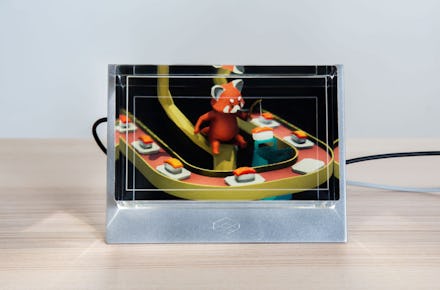This company wants to use holograms to improve medical research

Virtual and augmented reality devices seek to place us in the digital world around us, but they aren’t exactly convenient. A VR device like the Oculus Rift cuts out your sight of the real world as you wear a headset that’s too heavy for extended use. Google Glass offers an augmented reality experience but you look like a cyborg while wearing it.
However, the tech company Looking Glass is offering what it’s calling a better solution for bringing 3D objects to the real world: holograms.
Starting Tuesday, the holographic display from Looking Glass is available for purchase on Kickstarter and will ship later in 2018. Looking Glass’ co-founder hopes the product will revolutionize fields like simple 3D modeling and medicine. Shawn Frayne, co-founder and CEO, said holograms are more convenient than putting on a device like the Oculus Rift or HTC Vive. Surgeons, for example, can’t cover their eyes with the VR technologies currently on the market, but they could theoretically use Looking Glass’ display.
“You don’t have to put glasses on,” Frayne said in an interview with Mic during a demo of the display. “That alone is a big deal. Even in 20 years, when augmented reality glasses are as lightweight as sunglasses, it’s still less convenient for people who don’t normally wear glasses.”
The Looking Glass team has experimented with ways their product could be used for medical research including allowing people to analyze internal organs. The game controllers that come with the Nintendo Switch, for example, can be connected to the display. The controllers’ built-in motion detection and haptic feedback allow Looking Glass display owners to physically move the device to detect a heart’s irregularities. Other add-ons like the motion-detecting controller made by Leap Motion allow users to control what’s on screen without touching the display.
“It’s really difficult to parse how large a growing tumor is, for example, with a scan viewed on a 2D screen,” Frayne said. “A 3D display could conceivably offer a better sense of the volumetric size of it.”
The Looking Glass team is visiting hospitals to learn how the display can be implemented in medical procedures, help teach medical students and even do something as simple as show patients a detailed view of what’s happening inside their bodies.
“I don’t want to oversell the medical benefits before they’re actually out there helping people,” Frayne said. “One of the key things I hope happens over the next few years is [an] increase [in] the efficacy of a cancer diagnosis.”
The company imagines its device being used primarily as a second display for creators designing 3D models. Looking Glass also hopes buyers will use the device for casual video watching as well. Looking Glass’ holograms are different from what you’d see in Iron Man or other science-fiction movies — they don’t project into mid-air (the team found that those versions were too expensive for low-quality images). Instead, the company makes use of super stereoscopic 3D. Unlike regular 3D, which uses red and blue tinting to trick our brain into seeing an image popped out, this 3D technology makes use of stereoscopic images — meaning pictures taken at multiple angles to mimic depth. The Looking Glass display presents 45 simultaneous views of a scene.
“A VR headset gives you two stereoscopic views, one for each eye, but that only works for one person,” Frayne said. “Looking Glass’ super stereoscopic 3D lets a group of people all look at the display and see 3D.”
Viewers aren’t required to look at the image head-on to see the 3D, like some stereoscopic 3D devices, for example. They can view the device at an angle and still see the 3D effect.
The display does share one limitation with VR. In the current version, the Looking Glass display must be attached to a computer to work, but Frayne noted future versions will work on their own.
Looking Glass’ display may be more convenient than VR or AR for viewing digital objects, but it’s not exactly more convenient for your wallet. On the low end, the smaller display will cost you $600 while the larger model will run you $3,000. Good virtual reality products, on the other hand, costs around $400 to $500 if you already have a capable computer to attach it to.